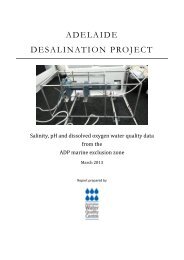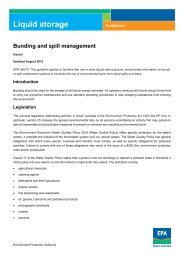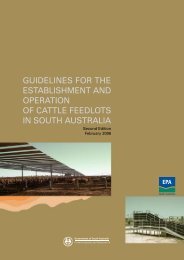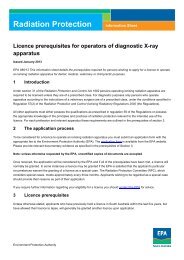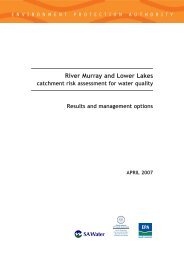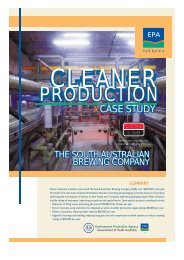Commercial Chicken Farms and Processors - EPA
Commercial Chicken Farms and Processors - EPA
Commercial Chicken Farms and Processors - EPA
You also want an ePaper? Increase the reach of your titles
YUMPU automatically turns print PDFs into web optimized ePapers that Google loves.
Executive Summary<br />
Review of On-Farm Disposal Treatment Risks <strong>and</strong> the Potential for Recycling of Wastes<br />
Produced from <strong>Commercial</strong> <strong>Chicken</strong> <strong>Farms</strong> <strong>and</strong> <strong>Processors</strong><br />
PPK Environment & Infrastructure Pty Ltd was commissioned by the South Australian Environment<br />
Protection Agency to undertake a review of the potential environmental <strong>and</strong> health impacts of on-farm<br />
disposal of chicken carcasses, <strong>and</strong> to recommend best practice methods for the environmentally<br />
sustainable management of chicken meat industry waste.<br />
The farming of chickens for the purpose of meat production leads to the generation of significant volumes<br />
(estimated to be 89,000 tonnes per annum) of solid wastes, which include chicken manure, feed residues,<br />
litter, dead chicken carcasses <strong>and</strong> meat processing residues. Poor management of these wastes can create<br />
major environmental <strong>and</strong> public health issues.<br />
Key environmental <strong>and</strong> public health issues for chicken farmers <strong>and</strong> processors include:<br />
¢ odour from the storage <strong>and</strong> decomposition of the waste<br />
¢ groundwater <strong>and</strong> surface water contamination from waste leachates generated during storage or<br />
on-farm disposal<br />
¢ vermin <strong>and</strong> fly infestation due to inadequate storage<br />
¢ dust, odour <strong>and</strong> the potential leakage of waste material during the transport of the waste<br />
¢ surface water pollution <strong>and</strong> nutrient overload in soils from the inappropriate application of<br />
litter/manure material<br />
¢ pathogen contamination on food produce from the inappropriate application of litter/manure<br />
material.<br />
Further, poor h<strong>and</strong>ling <strong>and</strong> management of chicken industry waste is deemed preventable, <strong>and</strong> is poor<br />
environmental practice.<br />
Initiatives in Australia <strong>and</strong> the United States have highlighted that chicken meat industry wastes can<br />
become a resource with the use of secondary <strong>and</strong> tertiary treatment systems. Valuable by-products from<br />
the treated chicken waste include fertiliser, soil amendment materials, processed material for animal<br />
consumption <strong>and</strong> animal fat by-products.<br />
Worlds Best Practice in the management of chicken industry waste is led by the United States of America<br />
(USA). Environmental strategies adopted by the poultry industry in the USA aim to eliminate the onfarm<br />
disposal of dead birds from normal mortality by January 1, 2002 (US, Poultry Industry 1998).<br />
Following trends established in the USA, technologies for composting waste from chicken breeder <strong>and</strong><br />
grower farms have been established in South Australia, yet on-farm disposal of chicken carcass waste is<br />
still common practice. It is well recognised by the majority of the chicken meat processing <strong>and</strong> farming<br />
industry that on-farm disposal of this waste should be discouraged where feasible, <strong>and</strong> associated wastes<br />
should be recovered for recycling into high quality compost material.<br />
Arrangements for rendering wastes from chicken meat processing plants are also well established for the<br />
major meat processors in South Australia.<br />
Through extensive consultation with the industry in South Australia, it has been established that the<br />
recovery <strong>and</strong> recycling of chicken industry wastes are well supported, <strong>and</strong> that on-farm disposal should be<br />
discouraged. This is supported by the following facts:<br />
¢ There are currently well-established markets in South Australia for compost <strong>and</strong> protein<br />
products generated from chicken waste material.<br />
¢ The potential for surface water contamination in catchment areas, such as the Mt Lofty Ranges<br />
Catchment, makes on-farm disposal an environmentally unacceptable option.<br />
Page v




